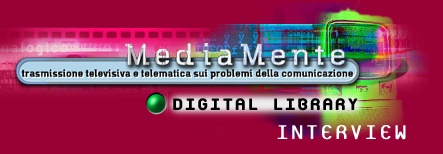Roma - Convegno Telework, 11/11/95
"The virtual city and teleworking"
SUMMARY:
- Telecity is a physical city with telecommunications institutions as well
as technology. The idea is to create a portal or a point of entry to cybercity. We need to
develop telecity before we all rush onto the Internet where there are no rules and it's a
very confusing world in this virtual reality (1).
- Telework Facilities Exchange is the world's largest multijurisdictional
telework facility space telework project.The Blueline Televillage is a start of a network
which may grow to 300 or 400 communication centres that provide a wide array of government
services, computing opportunities, distance education, video conferencing, and an entire
array of services that reflect the needs of the immediate community around them Telework
is only one of 4 families of network applications for an organisation. Organisational
change, corporate change, a mobile corporation is only one of five structural elements in
telecity. If you accommodate all five elements of telecity and all four families of
network applications within the corporation you have life returning to a neighbourhood and
community base and you don't have the isolation (2) (3).
|
|
INTERVIEW:
Question 1
You have recently participated in Telepolis in which you describe a new idea of the city.
One of the concepts related with telecommunication technology is that of the virtual city.
What is your idea of the virtual city?
Answer
I am working with a concept that I call telecity, which is a physical city with
telecommunications institutions as well as technology. And the idea is to create a portal
or a point of entry to cybercity. I think that we need to develop telecity before we all
rush onto the Internet where there are no rules and it's a very confusing world in this
virtual reality. The telecity is imposed upon a physical city that we all live with our
entire lives and it has neighbourhoods and physical places that we're comfortable with.
And I think that's what we have to remember. We live not in a virtual world, we live in a
physical world and I think that's where we have to start as we enter this greater journey
into cyberspace.

Question 2
Could you tell us about the most interesting project, telework, which you are currently
involved in?
Answer
As I said, I ran, I designed and implemented what I think is the world's largest
multijurisdictional telework facility space telework project. It was 148 cities, 4
counties in Southern California and was called the Telework Facilities Exchange where we
treated all public buildings as potential telework sites and we created a pool of
employees, of public employees, who then reported to the closest public facility to their
home as opposed to driving across the region as they all crossed each other. And the
results were terrific. It was a zero-fee facility so that you have now organisations like
government employees could in fact avail themselves of facilities-based telework. Other
than that, it costs anything from US$20 to $50 a day to get a telework station. So this
was the way of getting a co-operation between 148 governments to share their facilities so
their employees could work close to home. That was one. The second one is the Blue line
Televillage, which is a start of a network which I would hope to grow to 300 or 400
communication centres that provide a wide array of government services, computing
opportunities, distance education, video conferencing, and an entire array of services
that reflect the needs of the immediate community around them. And what would be exciting
about it would be to have a large network of these so that our lives can start to be
oriented more towards our community centres and not so much to long-distance commuting.

Question 3
Are there any risks, any social or cultural risks in the diffusion of telework?
Answer
I think that depends how it's done. You often hear at these conferences concerns over the
fragmentation of society and the isolation of the individual worker. I think if what I
advocate is a much broader planning process than what most organisations or most public
officials are willing to think about. As I said in my presentation, telework is only one
of 4 families of network applications for an organisation. And organisational change,
corporate change, that's what I call a mobile corporation or a mobile organisation, is
only one of five structural elements in what I call telecity. So whereas it's important, I
think the planning process has to accommodate all five elements of telecity and all four
families of network applications within the corporation. Now, if you do that, what you
have is life returning to a neighbourhood and community base and you don't have the
isolation, you don't have the fragmentation, but it really does depend on how it's done.

|
 |


